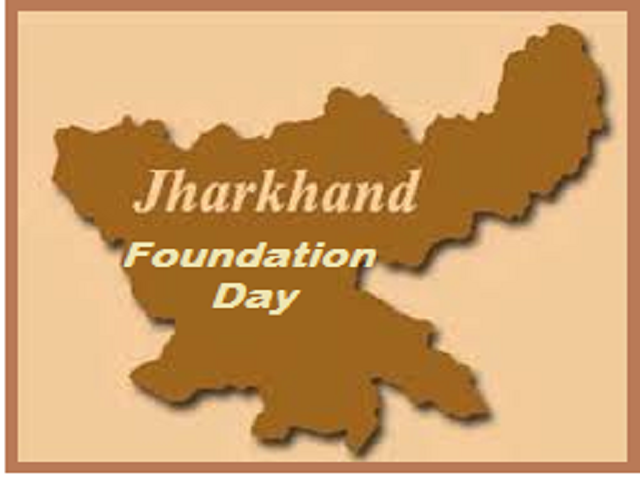Source – jagranjosh.com
Jharkhand is also known as ‘The land of forest” or ‘Bushland’. It is situated in eastern India and before establishment is the southern half of Bihar. Presently, Jharkhand state shares its border with Bihar to the north, Uttar Pradesh to the northwest, Chhattisgarh to the west, Odisha to the south and West Bengal to the east.
Jharkhand: Quick Facts
Area: approx. 79,716 sq. km
Population (2011 Census): approx. 32,988,134
Male Population (2011 Census): 16,930,315
Female Population (2011 Census): 16,057,819
Capital: Ranchi
Official Language: Hindi
Other Languages: Angika, Bengali, Bhojpuri, Ho, Kharia, Khortha, Kurmali, Kurukh, Magahi, Maithili, Mundari, Nagpuri, Odia, Santhali etc.
Largest City of Jharkhand: Jamshedpur
Districts: 24
National Highways: 1844 Km
State Highways: 6880 Km
Rank according to Area: 15
Rank according to population: 14
Density (2011 Census): 414 per sq. km.
Jharkhand State Animal: Indian Elephant
Jharkhand State Bird: Koel
Jharkhand Flower: Palash
Jharkhand Tree: Sal
Jharkhand: History
Jharkhand was carved out in 2000 out of the southern portion of Bihar. It is the homeland of the tribal’s who had dreamed of a separate state since long. After independence, people of Jharkhand state received little socioeconomic benefit, particularly tribal peoples. According to legend, in the 13th century, Raja Jai Singh Deo of Odisha had declared himself the ruler of Jharkhand.
The State of Jharkhand comprises forests of Chhotanagpur plateau and Santhal Pargana and has different cultural traditions. After independence, due to the Jharkhand Mukti Morcha’s regular agitation impelled the government to establish the Jharkhand Area Autonomous Council in 1995 and finally an independent State.
Jharkhand: Geography and Climate
Chota Nagpur Plateau in Jharkhand is a source of various rivers including Koel, Damodar, Brahmani, Kharkai, and Subarnarekha. Also, their upper watersheds lie within the Jharkhand. Most of the state is also covered with the forest and supports the populations of tigers and Asian Elephants. The soil of Jharkhand state is made up of rocks and stones and its compositions are divided into Red soil, Sandy soil, Black soil, and Laterite soil.
- Red soil is found in the Damodar valley, the Rajmahal area, Koderma, Jhumri Telaiya, Barkagaon.
- Sandy soil is found in the Mandar hills of Jharkhand in Hazaribagh and Dhanbad.
- Black soil in the Rajmahal area.
- Laterite soil in the western part of Ranchi, Palamu, parts of Santhal Parganas and Singhbhum.
There are three seasons in Jharkhand namely the cold-weather season, hot-weather season and southwest monsoon.
- The cold-weather season lasts from November to February.
- The hot-weather season lasts from March to mid-June.
- The southwest monsoon lasts from mid-June to October and brings rainfall in almost all the states.
Some more facts regarding Jharkhand State
– Jharkhand state is rich in mineral resources like coal, iron ore, copper ore, uranium, mica, bauxite, granite, limestone, silver, graphite, magnetite, and dolomite.
– Do you know that Jharkhand is the only state that produces coking coal, uranium, and pyrite?
– According to the data released by the Department of Industrial Policy and Promotion (DIPP), Jharkhand state has attracted Foreign Direct Investment (FDI) equity inflows worth US$ 113 million during April 2000 to December 2018.
– 80% rural population of the Jharkhand state depends upon agriculture for their livelihood.
– The major food crop of the Jharkhand state is rice.
– The most prominent multipurpose power project of Jharkhand is the Damodar Valley Corporation (DVC).
– High court is in Ranchi, with a chief justice and several other judges.
– Below high courts; district courts, sub-divisional courts, munsifs’ courts, and village councils are there.
– Jharkhand has more than 500 medical centres. Some large and well-equipped hospitals are located at Jamshedpur, Ranchi, and Dhanbad. Cancer hospital is situated in Jamshedpur. Treatment of tuberculosis, mental illness and leprosy are located near Ranchi.
– The leading causes of death in the state are due to respiration problems, dysentery, and diarrhoea. On the other hand Cholera and malaria also occur.
– The State has several universities including Ranchi University, Birsa Agriculture University, Sido Kanhu Murmu University, Vinoba Bhave University.
– The most recognised dance of Jharkhand is Chhau which is a masked dance basically performed in the southeastern region. Other tribal celebrations include a festival of flowers known as Sarhul, a cattle festival known as Sohrai and a post harvest festival called Mage Parab.
Therefore, on 15 November 2000, the Chota Nagpur region was separated from Bihar to form Jharkhand state i.e. the 28th state of India.
